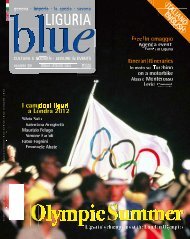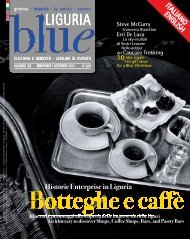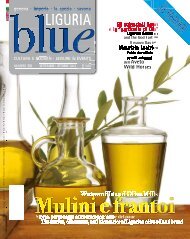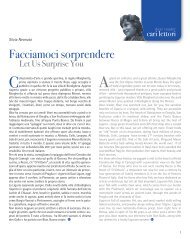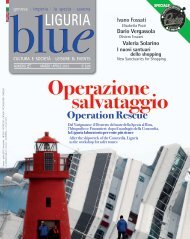Download PDF - Blue Liguria - Sagep
Download PDF - Blue Liguria - Sagep
Download PDF - Blue Liguria - Sagep
You also want an ePaper? Increase the reach of your titles
YUMPU automatically turns print PDFs into web optimized ePapers that Google loves.
lue<br />
cover<br />
broadcast as the “most<br />
spectacular vision which the<br />
Earth has ever seen”. A vision<br />
which in this case transmitted the<br />
images of an epic tragedy, from<br />
which we will have not recovered.<br />
Symbolically, it was the<br />
introduction for all the negative<br />
events that we are experiencing<br />
now today.<br />
We are missing Calvino in this<br />
moment, the lucidity of his pen.<br />
He who in his American lessons<br />
wished to speak of Lightness,<br />
Rapidity, Exactness, Visibility,<br />
Multiplicity. Looking at all these<br />
words lined up today, in the times<br />
of internet and globalization,<br />
they seem more pertinent than<br />
ever. The lectures, which he was<br />
to give during the academic year<br />
of 1985-86, were to be six,<br />
though he only wrote five. The<br />
sixth was to be called Consistency,<br />
a form of strength, tenacity, and<br />
solidity. Maybe that is why he<br />
never ended up writing it. Do we<br />
not live, as Bauman has<br />
suggested, in a liquid society In<br />
which little is able to deposit<br />
leave a sediment A rolling stone<br />
gathers no moss. From savings to<br />
memory, from work to affection.<br />
Born in North America, in Cuba,<br />
in 1923, Calvino docked in<br />
Sanremo, the city of his ancestors,<br />
at age two. During the Second<br />
World War, he joined the<br />
partisans in the woods of the<br />
mountains along the coast of<br />
<strong>Liguria</strong>. A landscape so important<br />
in his imagery, that it is the<br />
landscape of many of his tales<br />
and novels, including “The Baron<br />
in the Trees”. A book that has<br />
received universal recognition, an<br />
emblem of one of the Italian<br />
writers who has been most<br />
translated in the world, and most<br />
loved by Americans. That baron<br />
who decided to live in the trees is<br />
a world heritage.<br />
Calvino did not want to follow his<br />
father’s career as an agronomist.<br />
Nor did he want to be a scientist.<br />
He became a writer. “The Road to<br />
San Giovanni” - a sort of<br />
intellectual autobiography –<br />
sarebbe dovuta<br />
intitolare Consistency che mi<br />
azzardo a tradurre<br />
con consistenza ma<br />
anche fermezza, densità, solidit.<br />
Forse non è un caso che non sia<br />
riuscito a scrivere proprio<br />
quella. Non viviamo, come ci ha<br />
suggerito Bauman, nella società<br />
liquida, in cui ben poco si riesce<br />
a sedimentare Dai risparmi alla<br />
memoria, dal lavoro agli affetti.<br />
Nato a Cuba nel 1923, Calvino<br />
approda a Sanremo a due anni -<br />
la città dei suoi antenati per<br />
parte di padre. Durante la<br />
Seconda Guerra Mondiale si<br />
unisce ai partigiani in<br />
quell’entroterra ligure così<br />
importante per il suo<br />
immaginario, un paesaggio che<br />
si può ritrovare in molti racconti<br />
e romanzi, tra cui Il barone<br />
rampante. Un’opera<br />
universalmente riconosciuta,<br />
emblema di uno degli scrittori<br />
italiani più tradotti al mondo e<br />
molto amato dagli statunitensi.<br />
Quel barone che decide di vivere<br />
sugli alberi è patrimonio<br />
dell’umanità.<br />
Calvino non voleva seguire la<br />
carriera paterna, facendo<br />
l’agronomo, neppure lo<br />
scienziato, ma diventare<br />
scrittore. La strada di San<br />
Giovanni – una sorta di<br />
autobiografia intellettuale - è il<br />
racconto dove questo conflitto<br />
con il padre viene alla luce.<br />
Mario Calvino, le mattine<br />
d’estate, obbligava i figli ad<br />
accompagnarlo all’alba nell’orto<br />
di proprietà a San Giovanni per<br />
portare a casa le ceste di frutta<br />
e di verdura. Il giovane Italo,<br />
invece, era attratto dalla città,<br />
dal centro di Sanremo, “il resto<br />
era spazio bianco, senza<br />
significati; i segni del futuro mi<br />
aspettavo di decifrarli laggiù da<br />
quelle vie, da quelle luci<br />
notturne che non erano solo le<br />
vie e le luci della nostra piccola<br />
città appartata, ma la città, uno<br />
spiraglio di tutte le città<br />
possibili”. Due strade che<br />
divergono, si scontrano,<br />
brings out this conflict that he<br />
had with his father. Mario Calvino<br />
on summer mornings would force<br />
his children to accompany him at<br />
dawn to the vegetable gardens to<br />
bring home baskets of fruit and<br />
vegetables. The young Italo,<br />
instead, was attracted to the city,<br />
to the center of Sanremo, “the<br />
rest is a blank space, without<br />
meaning. The signs of the future<br />
awaited my deciphering of them<br />
down there, down those streets,<br />
down under those streetlights<br />
which were not just the streets<br />
and the lights of our little town,<br />
pushed to the side, but the city, a<br />
glimpse of all possible cities.” Two<br />
roads that diverged, that clashed,<br />
irreconcilable for the young Italo,<br />
but which, in future, when he<br />
became an adult, joined together<br />
to make a harmonious narrative.<br />
Like a Marco Polo of the 20th<br />
Century, he desired to leave his<br />
hometown, Sanremo, to cross all<br />
the cities possible. Marco Polo,<br />
and not by chance, is the main<br />
character of Calvino’s book,<br />
“Invisible Cities”. Calvino leaves<br />
<strong>Liguria</strong> forever after<br />
the Second World<br />
War. He moves<br />
first to Turin,<br />
then Paris and<br />
Rome.<br />
La locandina di "Dal fondo<br />
dell'opaco io scrivo", la mostra<br />
curata da Laura Guglielmi<br />
allestita alla New York<br />
University nel 1999, e la prima<br />
copertina di Lezioni americane.<br />
Sotto, la figlia di Italo Giovanna<br />
Calvino, da anni cittadina della<br />
Grande Mela<br />
The poster from the exhibition<br />
“From the Depths of the<br />
Opaque, I Write” which curator,<br />
Laura Guglielmi, set up at the<br />
University of New York in 1999,<br />
and the first cover of<br />
“American Lessons”. Below,<br />
Italo Calvino’s daughter,<br />
Giovanna, who for years has<br />
lived in New York City<br />
66



